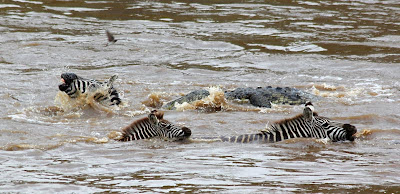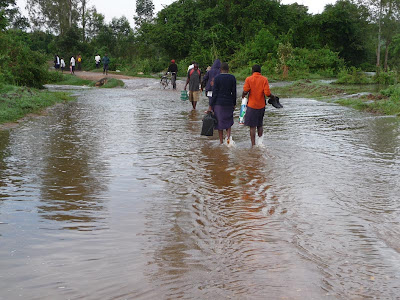Thursday, October 13, 2011
Population Multiplication
Land. The majority of Ugandans are currently subsistence farmers who are reliant on owning enough land to grow food for their whole family. Land is already becoming a scarcity for many farmers, and while most still have enough food, that could easily change for millions in the coming years. Subsistence farming is by definition extensive and has much lower productivity then modernized or commercialized farming. While modern, mechanized farming has caused many problems in the U.S., namely environmental, there is no denying that some level of scaling-up of agriculture is necessary to feed a growing population. But can this be done fast enough in Uganda, and effectively enough, to keep up with the increasing number of people?
Waste management. All Ugandan roadsides, towns, and cities are covered with trash because there is no formal waste management system. Even in the capitol city, there is trash strewn everywhere, clogging gutters and adding to an already-poor sanitation situation. While most rural Ugandans don’t produce nearly as much household waste as Americans, as they buy most of their food fresh and rarely buy packaged items, the influence of Western societies and increased urbanization is also increasing the amount of trash produced. I still find it shocking, 14 months after arriving here, when people throw their trash out the bus window or even into their own yard… but then I think, where else are they supposed to put it? The main method of dealing with rubbish here is burning it in piles. Even the U.S., with its reliance on landfills, does not have the perfect waste management solution, but at least we have some method to keep trash off our streets and out of our waterways.
Education. The education system is already rife with problems, with one of the biggest being too many students and not enough teachers. There is also a lack of actual school buildings and classrooms, with students often squeezed onto small benches in a crowded room that is not conducive to learning. Even within the next decade, there will be millions more children to educate than the system has to currently deal with. Without an education, people are forced to remain subsistence farmers, which, as detailed above, will become increasingly more difficult. Uneducated women will also continue to have many children. It’s hard to say how a timely solution will be found to this problem.
Electricity. Uganda already experiences regular rolling blackouts, sometimes for days at a time – and there are still many parts of the country which have no electricity at all. Not only will a larger population require more electricity, but people are increasingly moving to urban areas, and rural areas are demanding that they also be put on the grid.
Health. There is already a shortage of doctors, nurses, hospitals, medical equipment and supplies, etc. for the current population level. While an increase in population size will hopefully result in more people also being trained as health workers, it is likely that the increase will not meet the demand.
This list could really go on and on. While Uganda has problems now, I can only see them becoming much, much worse if the population continues to grow as it is. Honestly, within a relatively short amount of time (possibly a decade or two), I believe that there will be widespread chronic hunger and that Uganda will once again descend into chaos as people literally fight each other for survival. (And as a quick plug against foreign aid, can I just say that in 2010 alone, Uganda received almost $1.8 BILLION in foreign aid to fix these problems, and nothing ever seems to get better? And President Museveni can hardly blame this lack of results on his predecessors, a common American presidential tactic, as he's been in office since 1986 and has received $31 billion in foreign aid during that time)
What’s one solution to slowing down the population explosion? While the provision of family planning (contraceptives) is of course the main tool to reduce the fertility rate, it means nothing if people still desire a large family size. One of the most successful strategies at lowering fertility rates worldwide has not been provision of family planning, forced sterilization, a “one child rule”, etc. but rather increasing girls’ education. By ensuring that girls receive a full education, they are provided with an alternative to simply being a housewife. Women who are educated not only understand the health and economic benefits of having fewer children, but if they work outside the home, they also know that they must have fewer children or forfeit their career. Of course, men also have to be educated to see the benefits of a smaller family and to “allow” their wives to have fewer children, as many women in my village have to hide their contraceptive use from their husbands or risk being beaten. Many refuse to take The Pill, as it is easy for their husband to find out, and only come when the health center has Depo-Provera, the injectable contraceptive they get every 3 months. Gender equality is not just some feminist, 70’s, flower-power concept – it’s absolutely vital for development and even, in Uganda’s case, survival.
Saturday, October 1, 2011
Kenya - Safari Njema
After All Vol, I went with 4 other PCVs from my training group (Becca, Chelsea, Lisa, and Rashida) to KENYA! The trip was absolutely incredible. Nairobi was an impressively-large, much more developed city than Kampala. As we were passing through, I remarked, “Wow, look at all the traffic lights they have!” just as our taxi driver ran a red light. Oh well, nice try Kenya. The people seemed much less muzungu-crazed than in Uganda, and we were called ‘muzungu’ only a handful of times – a very nice break for us.
We saw many amazing things in Kenya, but our main objective was the Masai Mara National Reserve, which was probably the most amazing safari I’ve ever been on (and I’m privileged to have been on safaris all over East and Southern Africa). On our 4-day safari (with only two full days in the park), we saw 54 lions(!), 4 cheetahs, a leopard, elephants, giraffes, hyenas, ostriches, and hundreds of zebras. While this was all super impressive, the main reason we chose to go to the Masai Mara at this time of year was to see the wildebeest migration, which is featured in countless Discovery Channel and National Geographic documentaries. We were SO lucky to not only see the migration, with literally hundreds of thousands of wildebeest stretching up to the horizon, but we also saw them cross the infamous Mara River! After our safari, we had a chance to visit a Maasai village, which was interesting but of course touristy – at least it was a way for us to take unlimited photos without offending anyone. Overall, this was a once in a lifetime experience, and we are so lucky to have seen all that we did.

All those black dots? Wildebeest, as far as the eye can see

Wildebeest crossing the Mara River

Zebra being attacked by a crocodile!!! (surprisingly, the zebra got away and seemed fine)

An elusive leopard


A Maasai woman

The “Kenya Kitties”
When I came back to site after Kenya, the road into my village was flooded! I thought the taxi drivers had been joking when they said the road was impassable, but when I arrived at dusk, I had to wade through 100+ yards of water that sometimes reached halfway up my thigh (I’m short, but still!). Thankfully my house was nowhere near the danger zone and the water soon receded.

The water the next morning, after it had already gone done significantly!
I also recently had a chance to help train the newest group of trainees (who will soon swear in to be Peace Corps Volunteers). I talked about malaria prevention and what PCVs in Uganda did to celebrate World Malaria Day and raise awareness in our communities. I’m also coordinating with two local schools to do the World Map Project, through which the students will paint a giant map of the world on a wall of the school. One school is definitely on board, so we should start work next weekend. I’m really excited to get this going, as this is a project I’ve wanted to do since the beginning of service. The goal of the project is not only to increase the students’ knowledge about geography (which is very limited for even educated Ugandans), but to help them with critical thinking, creativity, mathematical methods such as drawing a grid system, and to build confidence by completing a big project that will be a beautiful, permanent fixture of the school. I’ll post photos as our map develops!
